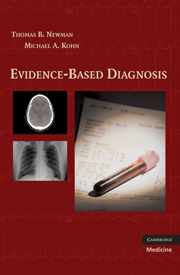Book contents
- Frontmatter
- Contents
- Preface
- Acknowledgments & Dedication
- Abbreviations/Acronyms
- 1 Introduction: understanding diagnosis and diagnostic testing
- 2 Reliability and measurement error
- 3 Dichotomous tests
- 4 Multilevel and continuous tests
- 5 Critical appraisal of studies of diagnostic tests
- 6 Screening tests
- 7 Prognostic tests and studies
- 8 Multiple tests and multivariable decision rules
- 9 Quantifying treatment effects using randomized trials
- 10 Alternatives to randomized trials for estimating treatment effects
- 11 Understanding P-values and confidence intervals
- 12 Challenges for evidence-based diagnosis
- Answers to problems
- Index
- References
7 - Prognostic tests and studies
Published online by Cambridge University Press: 04 August 2010
- Frontmatter
- Contents
- Preface
- Acknowledgments & Dedication
- Abbreviations/Acronyms
- 1 Introduction: understanding diagnosis and diagnostic testing
- 2 Reliability and measurement error
- 3 Dichotomous tests
- 4 Multilevel and continuous tests
- 5 Critical appraisal of studies of diagnostic tests
- 6 Screening tests
- 7 Prognostic tests and studies
- 8 Multiple tests and multivariable decision rules
- 9 Quantifying treatment effects using randomized trials
- 10 Alternatives to randomized trials for estimating treatment effects
- 11 Understanding P-values and confidence intervals
- 12 Challenges for evidence-based diagnosis
- Answers to problems
- Index
- References
Summary
Introduction
In previous chapters, we discussed issues affecting evaluation of diagnostic tests: how the reason to make a diagnosis may determine which tests should be done, how test reliability and accuracy are assessed, how to combine the results of tests with prior information to estimate the probability that a patient has a disease, and how to assess studies of diagnostic tests. In this chapter, we consider those same kinds of questions, with respect to prognostic tests.
Prognostic versus diagnostic tests
Prognosis is “a forecasting of the probable course and termination of an illness” (Webster's Unabridged Dictionary 2001). The main difference between prognostic tests and diagnostic tests is that, with prognostic tests, a time dimension is involved. With diagnostic tests, we are concerned with determining who does and does not have a disease. In this chapter, we begin with people who have a disease and try to predict their prognosis – that is, what will happen to them in the future. Thus, studies of prognostic tests generally have to be longitudinal in nature. That is, they need to follow a group of patients over time and allow measurement of incidence rather than just prevalence.
As was the case with studies of diagnostic tests, in which we compared test results among patients with and without the disease (a dichotomous variable), the outcome variable of a prognostic test study is generally also dichotomous – survival versus death, disease-free survival versus disease recurrence, and so on; each subject either does or does not develop that outcome.
- Type
- Chapter
- Information
- Evidence-Based Diagnosis , pp. 138 - 155Publisher: Cambridge University PressPrint publication year: 2009
References
- 2
- Cited by



